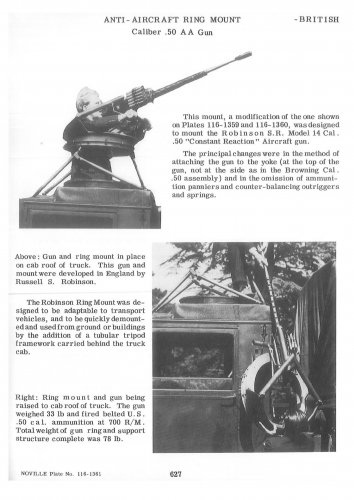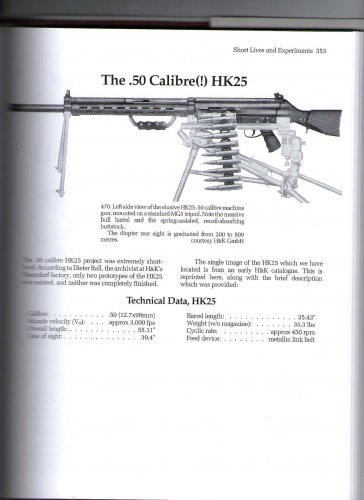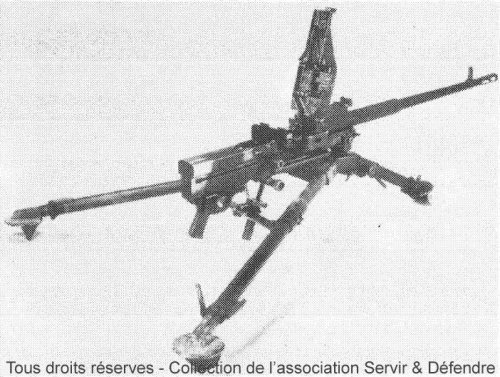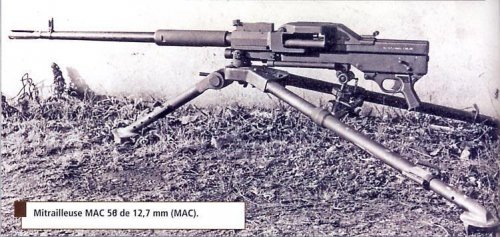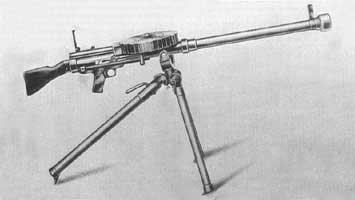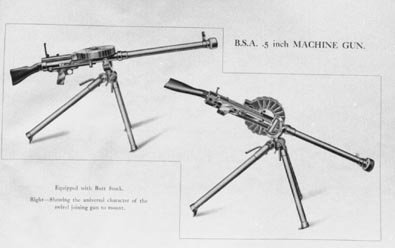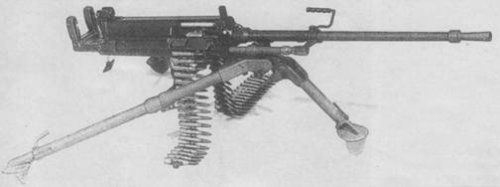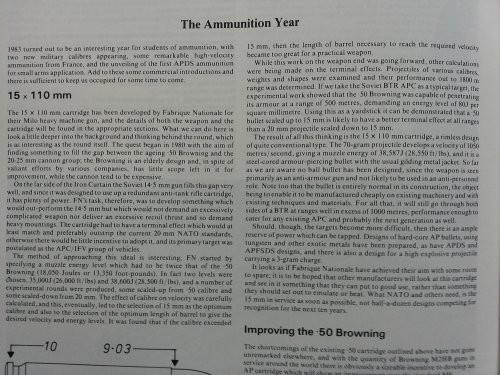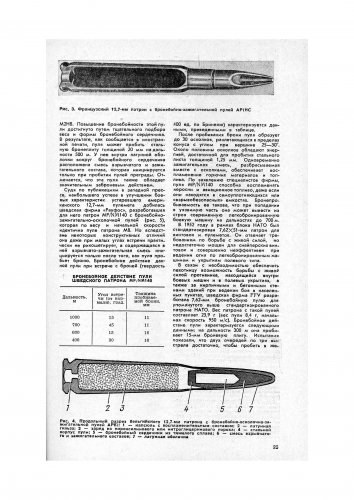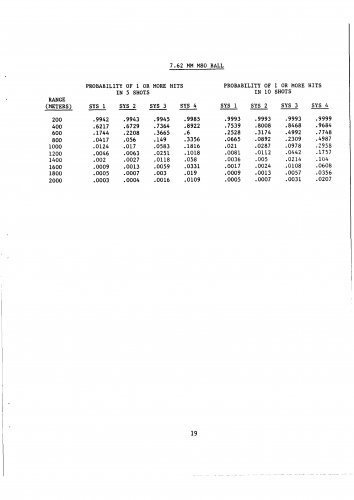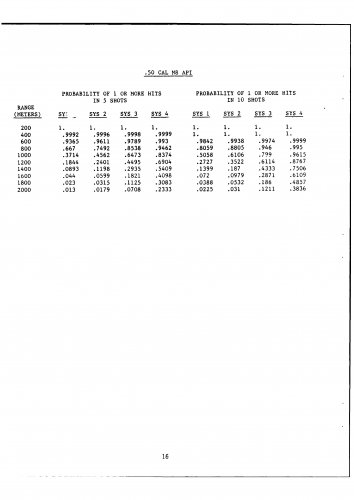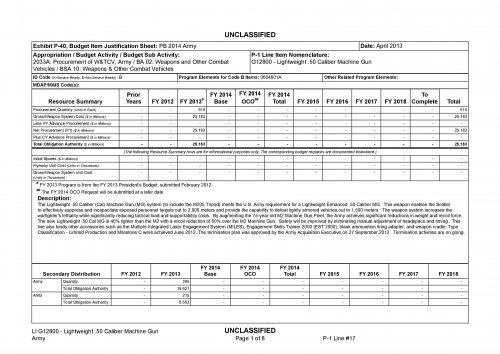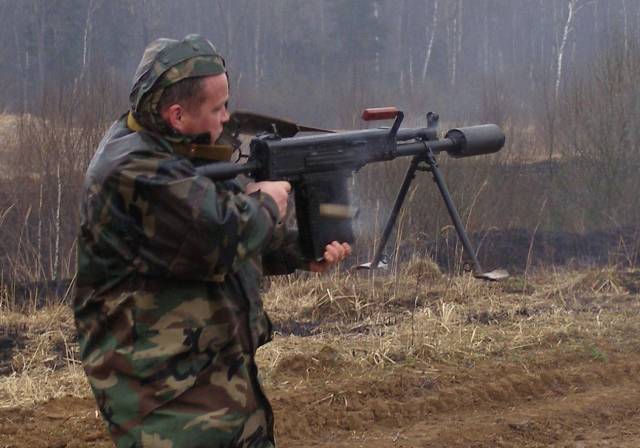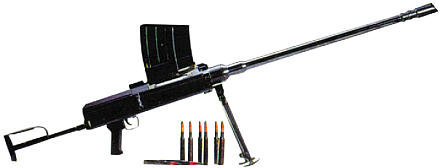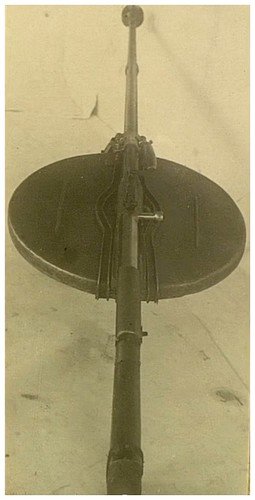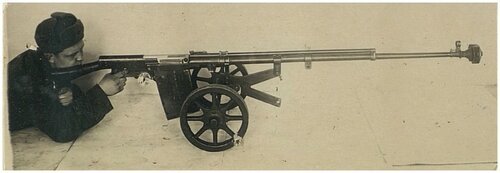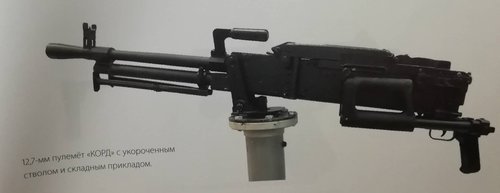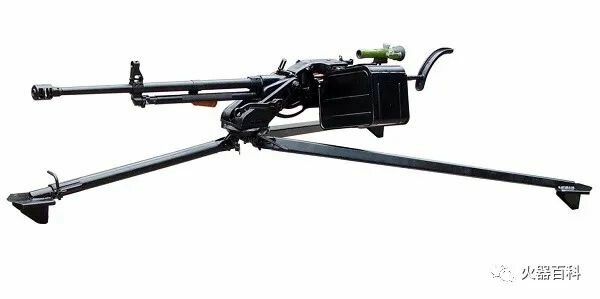You are using an out of date browser. It may not display this or other websites correctly.
You should upgrade or use an alternative browser.
You should upgrade or use an alternative browser.
lightweight 0.50 cal machine guns
- Thread starter tround
- Start date
C
CostasTT
Guest
AAI lightweight HMG, BSA Model 1924, MAC-58.
Of course, the Kord and the newest Chinese HMGs can be considered lightweight in my opinion, especially compared to the venerable M2 and DShK.
Additional info on the Robinson piece would be much appreciated, too.
Of course, the Kord and the newest Chinese HMGs can be considered lightweight in my opinion, especially compared to the venerable M2 and DShK.
Additional info on the Robinson piece would be much appreciated, too.
Attachments
lastdingo
Blogger http://defense-and-freedom.blogspot.de/
Large calibre machineguns have been limited almost entirely to vehicles not because of the gun weight, but because of the bulk and weight of the belted ammunition. It is rarely practical to use such weapons dismounted and far away from supporting vehicles or at least pack animals.
The heavy weight of the accessories (tripod mostly) is also an issue.
The new .338 machinegun project(s) may finally address this and widen the niche a bit, but I consider them to be rather for mounted employment as well.
The heavy weight of the accessories (tripod mostly) is also an issue.
The new .338 machinegun project(s) may finally address this and widen the niche a bit, but I consider them to be rather for mounted employment as well.
- Joined
- 18 March 2008
- Messages
- 3,529
- Reaction score
- 978
tround said:Robinson S.R. model 14 cal 50 and hk25
Thanks for the pictures and info.
- Joined
- 26 January 2011
- Messages
- 2,226
- Reaction score
- 645
There are finite limits on how light a weapon can be made and still absorb the recoil of a 12.7mm round. While there are tricks such as buffering and springs, you really can't go below a certain mass and still expect a ground mount and the man behind it to absorb the recoil efficiently. HMGs really are the preserve of vehicles, not tripods. MMGs/SFMGs/GPMGs/[insert acronym of choice] - rifle calibre, heavy barrelled/water cooled weapons are about the maximum sized calibre and weight which can be utilised by infantry.
tround
I really should change my personal text
- Joined
- 27 October 2012
- Messages
- 149
- Reaction score
- 77
There is a link on the Robinson machine gun but i'm not sure if it's true or not . http://fnfal.com/forums/showthread.php?t=76174
The hk25 , sr14 and dover devil are mounted on GPMG tripod ( 8 kg) .
It's true that there is a problem of logistic in the offensive . So you must employ the HMG on lucrative targets ie material targets and the key points of the enemy "device"
In the vietnam war , The ANV make a good use offensively of HMG particulary during the Lam son 719 operation against helicopters ( with prepositioned ammunitions )
I think that a HMG on tripod is usefull : defense of a base camp , a terrain with poor means of communication etc. even the heavy weight FN brg15 was mounted on a tripod and look the Dover Devil program for the light division and the constants progress made by Norinco during 40 years .
I think that the 0,338 must replace the GPMGs in 7,62x51 . But it can't remplace the 12,7 because
it was designed to be the minimum anti material caliber . (see Pershing specifications in 1918 and simply the MG TUF IN 13,2X92sr) . The french attempt to decrease the energy of HMG were failures : 9x66 10x71 11x78 cartridges . Even today the 12,7 remain the minimum anti material caliber .
To finish this post (but not the subject ) , I post the why and how of the brg15 machine gun .
Regards
The hk25 , sr14 and dover devil are mounted on GPMG tripod ( 8 kg) .
It's true that there is a problem of logistic in the offensive . So you must employ the HMG on lucrative targets ie material targets and the key points of the enemy "device"
In the vietnam war , The ANV make a good use offensively of HMG particulary during the Lam son 719 operation against helicopters ( with prepositioned ammunitions )
I think that a HMG on tripod is usefull : defense of a base camp , a terrain with poor means of communication etc. even the heavy weight FN brg15 was mounted on a tripod and look the Dover Devil program for the light division and the constants progress made by Norinco during 40 years .
I think that the 0,338 must replace the GPMGs in 7,62x51 . But it can't remplace the 12,7 because
it was designed to be the minimum anti material caliber . (see Pershing specifications in 1918 and simply the MG TUF IN 13,2X92sr) . The french attempt to decrease the energy of HMG were failures : 9x66 10x71 11x78 cartridges . Even today the 12,7 remain the minimum anti material caliber .
To finish this post (but not the subject ) , I post the why and how of the brg15 machine gun .
Regards
Attachments
lastdingo
Blogger http://defense-and-freedom.blogspot.de/
tround said:I think that the 0,338 must replace the GPMGs in 7,62x51 . But it can't remplace the 12,7 because
it was designed to be the minimum anti material caliber . (see Pershing specifications in 1918 and simply the MG TUF IN 13,2X92sr) . The french attempt to decrease the energy of HMG were failures : 9x66 10x71 11x78 cartridges . Even today the 12,7 remain the minimum anti material caliber .
Nobody should care about such entirely obsolete opinions.
Modern AFV are armoured in protection levels
- some against 7.52 mm long cartridge AP
- few types against 12.7 mm API
- many against 14.5mm API
the next real step is then 30 mm APDS or even APFSDS
.338 can penetrate the first category just as .50 can, and .50 can penetrate no other categories except with the still relatively exotic SLAP cartridges
The only advantage of .50 is that it can penetrate the first category at worse angles or longer distances, which isn't very important since such targets are very often poorly armed themselves (7.62 only) and could be engaged at short ranges.
The huge advantage of .338 is the much greater quantity of ammunition that can be carried inside the vehicle and the much higher practical rate of fire (.50 practical rate of fire in ground combat is very limited because ammo is so short; you'd normally want about 900 rpm).
Meanwhile, .338 is just as the .50 valuable for penetrating light cover (walls, trees, sandbags) and likely better for suppression (higher RoF, smoother manual aim).
By the way; the Polish 7.92 mm anti-tank rifle was no more or less a failure than 12.7, 14.5 or 15 mm ATRs. There's no minimum calibre for light armour penetration cast ins tone at all. In fact, 7.62x51 mm SLAP is very much capable against most APCs.
C
CostasTT
Guest
Very interesting, thanks. Unfortunately, because it is an old thread, the pictures in it are gone.tround said:There is a link on the Robinson machine gun but i'm not sure if it's true or not . http://fnfal.com/forums/showthread.php?t=76174
- Joined
- 18 March 2008
- Messages
- 3,529
- Reaction score
- 978
There is a bit of info about the Russel Robinson MGs and other firearms tech (he developed the squeeze bore multi round bullet) in this thread:
http://www.secretprojects.co.uk/forum/index.php/topic,3265.msg26456.html
Also Anthony G. Williamson's (forum member) book "Machinegun" has a bit of blurb about them.
http://www.secretprojects.co.uk/forum/index.php/topic,3265.msg26456.html
Also Anthony G. Williamson's (forum member) book "Machinegun" has a bit of blurb about them.
General Dynamics XM312

http://world.guns.ru/machine/usa/xm312-50-cal-e.html
and its successor
General Dynamics XM806 LW50MG

http://world.guns.ru/machine/usa/lw50mg-e.html
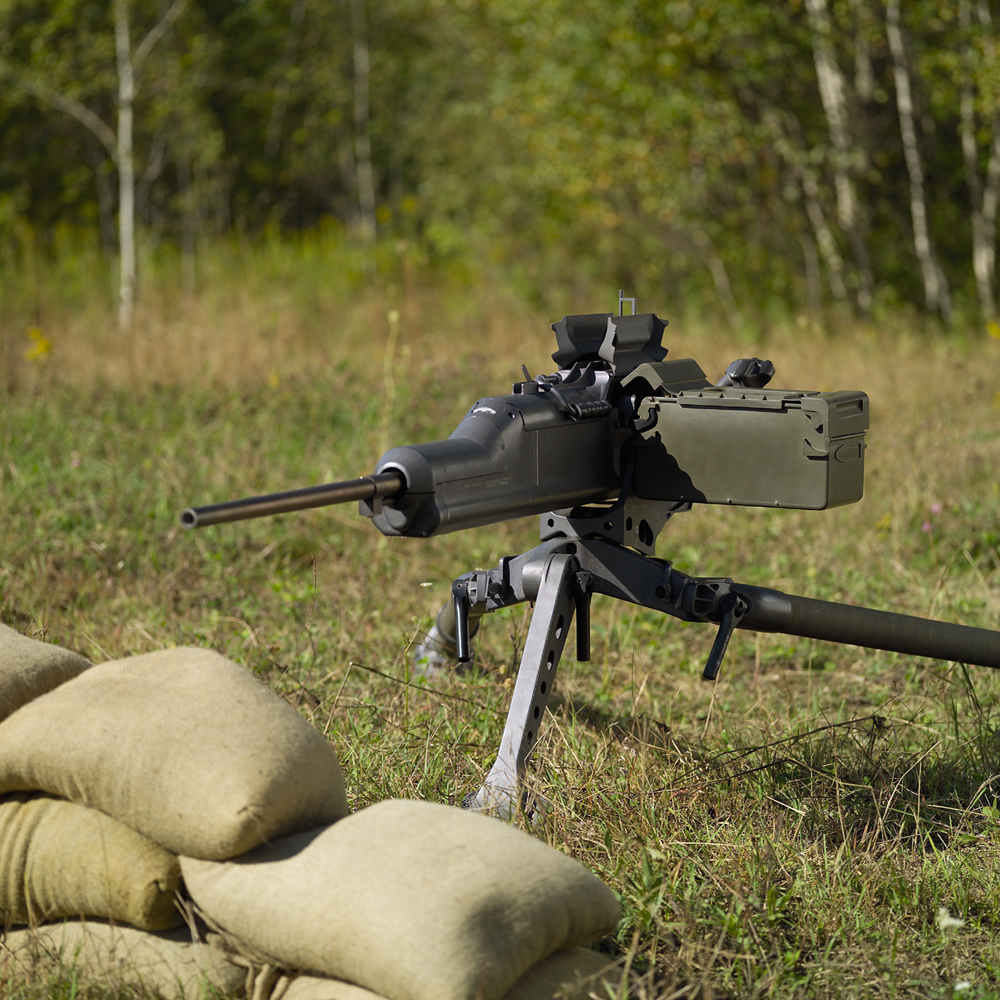
http://world.guns.ru/machine/usa/xm312-50-cal-e.html
and its successor
General Dynamics XM806 LW50MG

http://world.guns.ru/machine/usa/lw50mg-e.html
tround
I really should change my personal text
- Joined
- 27 October 2012
- Messages
- 149
- Reaction score
- 77
Lastdingo
The AFV isn't the only target of the HMG .There is also the helicopters and the samll calibers have a low probability of kill .
The Polish 7,92 is only an antitank cartridge not an antimaterial cartridge .
12,7 ammos in a M113 or a M1 are not « very short »
The chinese and russian AFV are not protected like the western AFV .
SLAP are not exotics , also the armor penetration of the 12,7 can be increase with APFSDS .Such projectiles are very effective .
May be the GPHMG in 20x102 will be very good answer to the increase of armor protection (3,8 inch bhn 250 steel armorl at 1000 Yd but , the problem is the stabilization of the flechette fired in a rifled barrel ) .
But sure , if you have plenty of antitank weapons , the armor piercing requirement of the 12,7 is useless . But for some country (ukraine …) is usefull to have APDS for their HMG .
I'm septical on the capabilities of the 0,338nm vs the 0,50 against urban targets .
The AFV isn't the only target of the HMG .There is also the helicopters and the samll calibers have a low probability of kill .
The Polish 7,92 is only an antitank cartridge not an antimaterial cartridge .
12,7 ammos in a M113 or a M1 are not « very short »
The chinese and russian AFV are not protected like the western AFV .
SLAP are not exotics , also the armor penetration of the 12,7 can be increase with APFSDS .Such projectiles are very effective .
May be the GPHMG in 20x102 will be very good answer to the increase of armor protection (3,8 inch bhn 250 steel armorl at 1000 Yd but , the problem is the stabilization of the flechette fired in a rifled barrel ) .
But sure , if you have plenty of antitank weapons , the armor piercing requirement of the 12,7 is useless . But for some country (ukraine …) is usefull to have APDS for their HMG .
I'm septical on the capabilities of the 0,338nm vs the 0,50 against urban targets .
lastdingo
Blogger http://defense-and-freedom.blogspot.de/
Helicopters have partial armour protection up to against 14.5 mm API (fuel lines, for example). Most surface are 'soft' or only meant to protect against normal (7.62) calibres.
There's again little difference between .338 and .50 bullet effect - and ammunition supply + RoF allow many more .338 than .50 bullets fired at the helo.
"12,7 ammos in a M113 or a M1 are not « very short »"
on board M1 Abrams: 12.7 in the high hundreds, 7.62 in the high thousands
.338 would unify this into one calibre
There's again little difference between .338 and .50 bullet effect - and ammunition supply + RoF allow many more .338 than .50 bullets fired at the helo.
"12,7 ammos in a M113 or a M1 are not « very short »"
on board M1 Abrams: 12.7 in the high hundreds, 7.62 in the high thousands
.338 would unify this into one calibre
Here's a promotional clip of the GD LW50MG, note the low rate of fire and apparently very well mitigated recoil. I can see a role for such guns as a UAV-based semi-auto sniping weapon as well.
http://youtu.be/rLYa0uA7OG0
http://youtu.be/rLYa0uA7OG0
lastdingo
Blogger http://defense-and-freedom.blogspot.de/
tround said:I am not on that the 0,338 NM can replaces the 0,50 in all circumstances .
The 0,338 lapua magnum at 1000M has 3 times less kinetic energy .
So what?
It's smaller, so it requires less energy to penetrate, too.
And who cares about energy? It's just a means to an end.
I already mentioned it's likely going to penetrate counter-7.62 armor at smaller distances than .50, and neither penetrate counter-12.7 armor at any distance (save for SLAP, but then it's about different effective ranges again).
.338 could be used as a unified mounted combat calibre, so it would be quite an upgrade for 7.62 installations and a slight downgrade for .50 installations. You might upgrade the 7.62's to .338, and once you've got that you have too little justification for keeping .50.
It's not going to happen easily or likely because of technological lock-in, but a mix of 7.62 and .50 in a single vehicle or vehicles armed with 7.62 only (Bundeswehr mounted 7.62 MG3 on many of its AFVs, not using .50cals when avoidable since the 70's, for example) make little sense when .338 is an option.
tround
I really should change my personal text
- Joined
- 27 October 2012
- Messages
- 149
- Reaction score
- 77
0,338 LP ap485 (tungsten core) penetration at 1000M : 7,5 mm BHN 400 10mm 800M
0,50 PPI (ap2 ,improved steel core ) idem 13 mm BHN 360
C44 APT (tungsten) 350 BHN 22mm 800M
It's not a slight downgrade . It is not only a problem of perforated steel but also of sandbags , stones concrete walls . In this cases you need more ammunitions and , more important , more time to destroy the targets .
The 0,338 improved the suppresive power (compared with 7,62 and 0,50 ) against soft targets .
But against hard targets , i'm not sure .
Also The brochure of the LWMMG said : »At 1,000 meters, the LWMMG is capable of defeating Level III body armor (M80 ball , lead core , point blank) and incapacitating soft skinned vehicles »
There is the question of the engagement range of the M2 . I have no statistics (50% and 90% ) .
If the ranges are shorts may be 0,338 is a good alternative (performance of a steel core AP ?) if there isn't armor threat .
And again , the choice to replace the 7.62 and 0,50 by the 0,338 depends on the countries we are talking about and of its potential enemies .
0,50 PPI (ap2 ,improved steel core ) idem 13 mm BHN 360
C44 APT (tungsten) 350 BHN 22mm 800M
It's not a slight downgrade . It is not only a problem of perforated steel but also of sandbags , stones concrete walls . In this cases you need more ammunitions and , more important , more time to destroy the targets .
The 0,338 improved the suppresive power (compared with 7,62 and 0,50 ) against soft targets .
But against hard targets , i'm not sure .
Also The brochure of the LWMMG said : »At 1,000 meters, the LWMMG is capable of defeating Level III body armor (M80 ball , lead core , point blank) and incapacitating soft skinned vehicles »
There is the question of the engagement range of the M2 . I have no statistics (50% and 90% ) .
If the ranges are shorts may be 0,338 is a good alternative (performance of a steel core AP ?) if there isn't armor threat .
And again , the choice to replace the 7.62 and 0,50 by the 0,338 depends on the countries we are talking about and of its potential enemies .
lastdingo
Blogger http://defense-and-freedom.blogspot.de/
tround said:It's not a slight downgrade . It is not only a problem of perforated steel but also of sandbags , stones concrete walls . In this cases you need more ammunitions and , more important , more time to destroy the targets .
Keep in mind that even 7.62 is somewhat effective against many walls, tree and sandbag covers.
Also, .338 can have twice the RoF of common .50 and be more easily controllable (in manual employment), so I doubt it's doing the job more slowly.
Penetration in millimetres is furthermore irrelevant except at long ranges (the rather unlikely ones). Both can penetrate common covers and neither can penetrate anti-.50 cover/plates (except with exotic ammo, and yes, SLAP is exotic and will rarely be the ready ammunition).
jsport
what do you know about surfing Major? you're from-
- Joined
- 27 July 2011
- Messages
- 7,732
- Reaction score
- 5,751
tround said:Robinson S.R. model 14 cal 50 and hk25
wow, thank you Tround for confirming HK 25 idea was not and internet legend..
The .50 cal ammo does have one advantage over .338 - the size of the bullet makes it possible to pack in some useful chemicals, as in the Nammo Raufoss Multipurpose SAPHEI (in US service as the MK211). This is claimed to have a similar destructive effect to traditional 20mm cannon shells. The HEI content will clearly make it more effective against a range of targets which are vulnerable to being blown up and/or set alight.
lastdingo
Blogger http://defense-and-freedom.blogspot.de/
The possible explosive content would still be tiny and adds to the safety precautions required.
The more explosive you add -> the lighter the shell -> worse sectional density -> worse ballistic coefficient -> worse external ballistics -> lower probability of hit especially in short bursts and great drop in penetration at longer ranges.
7.62 and .338 are easily capable of incendiary effect, and .338 can combine a long range tracer with incendiary effect.
The more explosive you add -> the lighter the shell -> worse sectional density -> worse ballistic coefficient -> worse external ballistics -> lower probability of hit especially in short bursts and great drop in penetration at longer ranges.
7.62 and .338 are easily capable of incendiary effect, and .338 can combine a long range tracer with incendiary effect.
lastdingo said:The possible explosive content would still be tiny and adds to the safety precautions required.
The more explosive you add -> the lighter the shell -> worse sectional density -> worse ballistic coefficient -> worse external ballistics -> lower probability of hit especially in short bursts and great drop in penetration at longer ranges.
That makes several incorrect assumptions. The Nammo Multipurpose is ballistically matched to the standard .50 cal ammo: the bullet is the same weight and shape and is fired at the same velocity, so it has the same trajectory and hit probability. The use of lighter chemicals in the core is balanced by the addition of a heavier tungsten carbide penetrator which can penetrate 16mm of armour plate at 60 degrees and 400m. After penetration the bullet explodes and distributes about 20 effective fragments, plus a shower of incendiary particles which are still effective 15m behind the target plate.
7.62 and .338 are easily capable of incendiary effect, and .338 can combine a long range tracer with incendiary effect.
You can't get away from the fact that the .50 bullet weighs c.2.5 times as much as .338 and 5 times as much as 7.62mm (the difference in size is even greater than that, because the standard .50 ball core is steel, not lead). So the .50 can carry far more HEI mix than the smaller calibres.
The Multipurpose is also available with a tracer (which traces up to 1,500m) at the cost of a 30% reduction in the fragments, but no reduction in penetration or incendiary effect.
tround
I really should change my personal text
- Joined
- 27 October 2012
- Messages
- 149
- Reaction score
- 77
Also, .338 can have twice the RoF of common .50 and be more easily controllable (in manual employment), so I doubt it's doing the job more slowly.
Penetration in millimetres is furthermore irrelevant except at long ranges (the rather unlikely ones). Both can penetrate common covers and neither can penetrate anti-.50 cover/plates (except with exotic ammo, and yes, SLAP is exotic and will rarely be the ready ammunition).
There is a requirement for great ranges . 2000 meters against personnel and 1500m against APC . The heavy weapons need great ranges in the purpose of extend the cover of small units (squad etc).
The mechanism of the penetration is independant of the media : Velocity , sectional density , diameter .
The 0,50 is more versatile and it is what the armies need . The 0,50 can suppress many covers that the 0,338 can't , particulary at long range .
There is little difference in accuracy , in short burst between a M60 and a M2 . (system 1 in the document : iron sight ) . An 0,50 machine gun with a quick change barrel is not disadvantaged and you need more time to aiming than any other tasks .
the document :"FIRE CONTROL ANALYSIS OF SELECTED CREW SERVED WEAPONS" DTIC
Attachments
lastdingo
Blogger http://defense-and-freedom.blogspot.de/
Well, now you're in tungsten carbide territory. That's exotic stuff that's not going to be normal equipment for regular infantry any time soon. It's exotic like SLAP which employs the same.
A discussion about the utility of a specific calibre should be about ammunition that's realistic as standard issue, otherwise we could discus how accurate machineguns can be with Match cartridges; pointless. You don't choose hardware for the 5% gold plated extra stuff, but for the 95% regular issue consumables.
@tround; even MBTs have a hard time exploiting that kind of ranges against infantry. The stupid folks who readily show themselves die out quickly, and the bulk of the opposing forces is hardly ever visible at 300 metres or less.
An IFV, MBT or recce AFV needs no machinegun to defeat a light AFV, and other AFVs or soft motor vehicles better avoid getting into a fight with an APC at 1+ km and break contact ASAP, at least break LOS.
A discussion about the utility of a specific calibre should be about ammunition that's realistic as standard issue, otherwise we could discus how accurate machineguns can be with Match cartridges; pointless. You don't choose hardware for the 5% gold plated extra stuff, but for the 95% regular issue consumables.
@tround; even MBTs have a hard time exploiting that kind of ranges against infantry. The stupid folks who readily show themselves die out quickly, and the bulk of the opposing forces is hardly ever visible at 300 metres or less.
An IFV, MBT or recce AFV needs no machinegun to defeat a light AFV, and other AFVs or soft motor vehicles better avoid getting into a fight with an APC at 1+ km and break contact ASAP, at least break LOS.
lastdingo said:Well, now you're in tungsten carbide territory. That's exotic stuff that's not going to be normal equipment for regular infantry any time soon. It's exotic like SLAP which employs the same.
A discussion about the utility of a specific calibre should be about ammunition that's realistic as standard issue, otherwise we could discus how accurate machineguns can be with Match cartridges; pointless. You don't choose hardware for the 5% gold plated extra stuff, but for the 95% regular issue consumables.
Ammunition cost is primarily an issue with small arms which go through vast quantities of the stuff: 5.56mm and 7.62mm. The bigger the calibre, the smaller the number fired in combat, and the more important becomes the effectiveness of each shot, rather than the cost. The MK211 is a standard ammo type in the US inventory. Sure, for as long as insurgents like the Taliban are the targets, standard ball ammo will do the job well enough - but as soon as vehicles, helicopters and other targets which would benefit from the application of HEI appear, those guns will be loaded with MK211.
Edit to add: I should also have mentioned that the most effective .338 Lapua AP loadings have tungsten cores...e.g. the RUAG Swiss P AP and API.
AAI lightweight HMG, BSA Model 1924, MAC-58.
Of course, the Kord and the newest Chinese HMGs can be considered lightweight in my opinion, especially compared to the venerable M2 and DShK.
Additional info on the Robinson piece would be much appreciated, too.
Do you have any further information on the AAI 12.7mm Lightweight HMG? Or can anyone here point me at a post or somebody who does happen to have that information?
Bottleship
ACCESS: Secret
- Joined
- 30 June 2019
- Messages
- 493
- Reaction score
- 1,264
Ravinoff
Hoodoo Operator
- Joined
- 5 October 2017
- Messages
- 130
- Reaction score
- 297
While not exactly qualifying as lightweight .50 MGs, here's a couple interesting interwar oddities: the Browning M2 "Anti-Mechanization Weapon" courtesy of Forgotten Weapons.



These were pretty much exactly what they look like: shoulder-fireable M2s for anti-materiel use, or basically an attempt at making an M2 into an antitank rifle. Like the rest of the antitank rifle family they were eventually just deemed too huge and heavy with no real benefit over a regular tripod or fixed mount.
And of course there's the Kord 12.7, weighing in at a heavy but manageable ~65 pounds in its lightweight configuration, and looking damned impressive when fired from the hip.
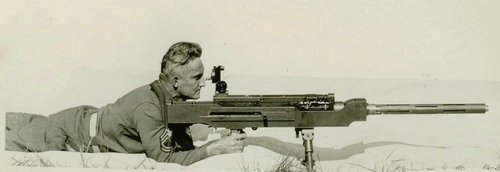
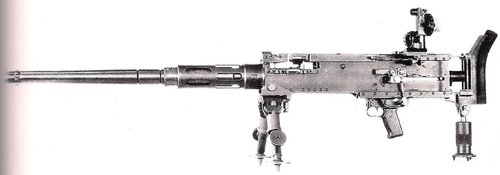
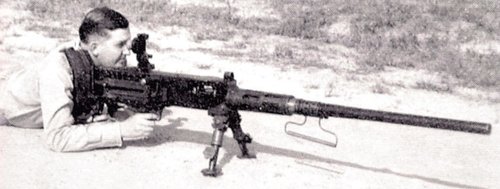
These were pretty much exactly what they look like: shoulder-fireable M2s for anti-materiel use, or basically an attempt at making an M2 into an antitank rifle. Like the rest of the antitank rifle family they were eventually just deemed too huge and heavy with no real benefit over a regular tripod or fixed mount.
And of course there's the Kord 12.7, weighing in at a heavy but manageable ~65 pounds in its lightweight configuration, and looking damned impressive when fired from the hip.
AAI lightweight HMG, BSA Model 1924, MAC-58.
Of course, the Kord and the newest Chinese HMGs can be considered lightweight in my opinion, especially compared to the venerable M2 and DShK.
Additional info on the Robinson piece would be much appreciated, too.
Do you have any further information on the AAI 12.7mm Lightweight HMG? Or can anyone here point me at a post or somebody who does happen to have that information?
Not sure about AAI, but they have worked with ARES in plastic-cased telescoped ammo systems.
Before that, ARES developed the .50 PCTA (Plastic Cased Telescoped Ammunition) in the mid/late 1980s which matched the performance of the .50 BMG round but with weight reduced by 33%. To use, it they first developed TAMG (Telescoped Ammunition Machine Gun) with a 40% reduction in the weight of the M2HB, and then the TARG (.50 cal Telescoped Ammunition Revolver Gun) for aircraft use. Both weighed around 45 lbs (20.4 kg) but the TARG was designed to fire at 1,400-2,000 rpm.
The .50 PCTA (TARG) is shown below, along with some other .50 ammo concepts:

Bottleship
ACCESS: Secret
- Joined
- 30 June 2019
- Messages
- 493
- Reaction score
- 1,264
Christopher Wang
ACCESS: Secret
- Joined
- 3 June 2021
- Messages
- 274
- Reaction score
- 586
Could the Raufoss Mk 211 be fired from aircraft machine guns such as the Browning AN/M2 used in WW2 aircrafts (e.g. P-51 Mustang, P-47 Thunderbolt, etc.)?The .50 cal ammo does have one advantage over .338 - the size of the bullet makes it possible to pack in some useful chemicals, as in the Nammo Raufoss Multipurpose SAPHEI (in US service as the MK211). This is claimed to have a similar destructive effect to traditional 20mm cannon shells. The HEI content will clearly make it more effective against a range of targets which are vulnerable to being blown up and/or set alight.
Scott Kenny
ACCESS: USAP
- Joined
- 15 May 2023
- Messages
- 11,628
- Reaction score
- 14,321
Absolutely.Could the Raufoss Mk 211 be fired from aircraft machine guns such as the Browning AN/M2 used in WW2 aircrafts (e.g. P-51 Mustang, P-47 Thunderbolt, etc.)?
Many of the MGs used in the GWOT were originally aircraft guns, dug out of some warehouse and refitted.
Firefinder
ACCESS: Top Secret
- Joined
- 5 October 2019
- Messages
- 1,048
- Reaction score
- 1,899
So long as the round dimensions or pressures have not change.
Odds are high that you can take a rifle built in 1903 and shot the newest 2024 hotness without an issue.
Standards are fun like.
Like hell theres still WW2 veterans M2s bouncing around the armories with the attachment points for the water janket. My old unit had one in 2020.
Any new ammo needs to be made with that in mind.
Odds are high that you can take a rifle built in 1903 and shot the newest 2024 hotness without an issue.
Standards are fun like.
Like hell theres still WW2 veterans M2s bouncing around the armories with the attachment points for the water janket. My old unit had one in 2020.
Any new ammo needs to be made with that in mind.
Scott Kenny
ACCESS: USAP
- Joined
- 15 May 2023
- Messages
- 11,628
- Reaction score
- 14,321
When the M2s were getting the A1 upgrade to quick change barrels, the depot doing the QCB mod found a gun with a THREE-DIGIT serial number, dating to ~1924 or so. Still in use in the 20teens.So long as the round dimensions or pressures have not change.
Odds are high that you can take a rifle built in 1903 and shot the newest 2024 hotness without an issue.
Standards are fun like.
Like hell theres still WW2 veterans M2s bouncing around the armories with the attachment points for the water janket. My old unit had one in 2020.
Any new ammo needs to be made with that in mind.
Scott Kenny
ACCESS: USAP
- Joined
- 15 May 2023
- Messages
- 11,628
- Reaction score
- 14,321
I should also add that .50BMG runs pretty high pressures for a small arms round, some 62kpsi. While 7.62x51 and 5.56 both run about 55k.So long as the round dimensions or pressures have not change.
Odds are high that you can take a rifle built in 1903 and shot the newest 2024 hotness without an issue.
Standards are fun like.
Like hell theres still WW2 veterans M2s bouncing around the armories with the attachment points for the water janket. My old unit had one in 2020.
Any new ammo needs to be made with that in mind.
So honestly, you can do a lot with the powder to adjust how fast it burns. For example, the SLAP rounds use a ball powder instead of the extruded type powder that the 5.56 tends to use. If you watch firearms content on youtube, I'm sure you're aware of Kentucky Ballistic's kaboom from a SLAP round. I suspect that was from some nasty, grungy round that some dude had thrown into a tumble polisher to clean up, and all those vibrations broke the powder balls into smaller pieces that burned a lot faster and made immensely higher pressure.
But with modern ammo you can tailor your burn time to take full advantage of the 45" long barrel on an M2HB and get even more speed out of the round. Hornady did a similar idea with their Superperformance line of ammo. Generally slower burning powder so that the gasses had completely expanded when the bullet reached the muzzle. Less recoil and more speed for the same bullet weight.

